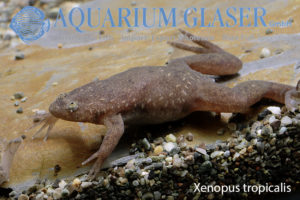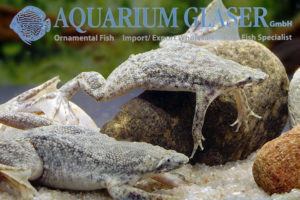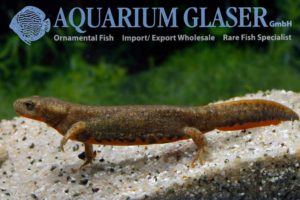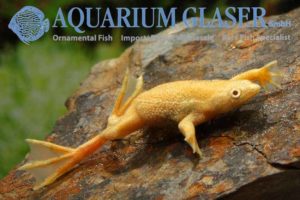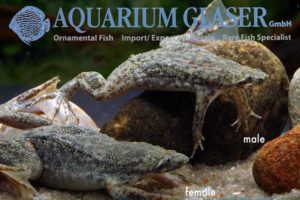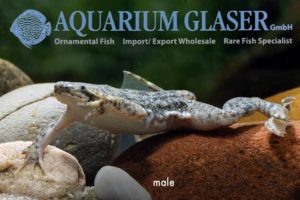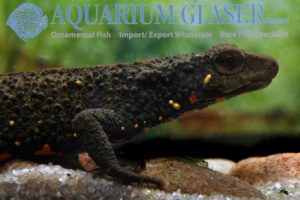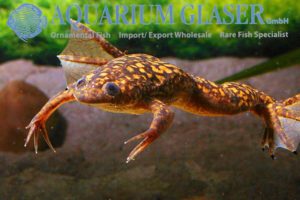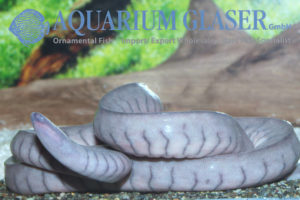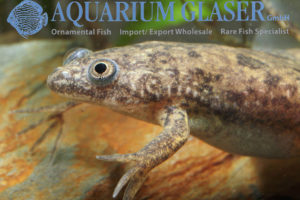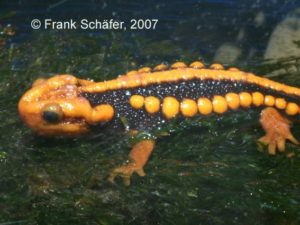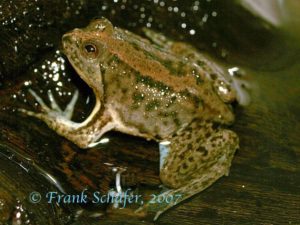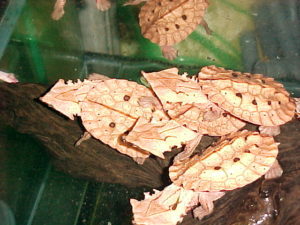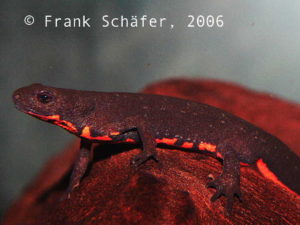Most likely, the trade of clawed frogs of the species Xenopus laevis will soon be banned because a reproducing population has been discovered in France. Due to climate change, it is now feared that this species could become invasive in Europe. To prevent this, the trade with this species should be prohibited. We would like […]
30. Amphibians and Reptiles (16)
-
-
Pipa parva
The dwarf Surinam toad (Pipa parva) from Venezuela is a real rarity in the aquarium. We have a breeder who can occasionally offer us some of them. At first sight the nice animals remind us of dwarf clawed frogs (Hymenochirus), but you can always tell them apart from them by the branched fingertips – typical […]
-
Cynops cf. cyanurus
The fire bellied newts of the genus Cynops are perfect aquarium newts. Most specimens can be easily adapted for a life in water the whole year through. This makes feeding a lot easier, because on land newts are very secretive and feed only on live food, while in the water they also readily accept frozen […]
-
Hymenochirus boettgeri Gold-Albino
Hymenochirus boettgeri Gold-Albino The most popular of all underwater frogs is the Dwarf Clawed Frog Hymenochirus boettgeri. It is bred as an ornamental animal for years already. So it was only a matter time when albinos would appear in the market: and here they are! Really nice animals, aren´t they? For our customers: the frogs […]
-
Pipa parva
The Dwarf Suriname Toad from Venezuela is a real rarity in aquaria. We have a breeder that is able to offer us some specimens every now and then. At the first glimpse they nice animals remind one on Dwarf Clawed Frogs (Hymenochirus). However, like all other Pipa species, P. parva has ramifications on the top […]
-
Pipa parva
The Dwarf Suriname Toad from Venezuela is a real rarity in aquaria. We have a new breeder that is able to offer us some specimens every now and then. At the first glimpse they nice animals remind one on Dwarf Clawed Frogs (Hymenochirus). However, like all other Pipa species, P. parva has ramifications on the […]
-
Paramesotriton chinensis
Springtime is the time for amphibians. In Germany toads, frogs, and newts leave their winter lairs and turn back to the ponds where they have been born to spawn. The very same happens in other parts of the world that have a similar climate. So we now get newts from China sometimes. Paramesotriton chinensis is […]
-
Xenopus laevis
By chance we had the opportunity to get wonderful, large (6-8 cm) Xenopus laevis from a German breeder. Available only in limited numbers! For our customers: the animals have code 192505 on our stocklist. Please note that we exclusively supply the wholesale trade.
-
Potamotyphlus kaupii
Most people interested in natural history know two orders within the class Amphibia, namely the Anura (frogs, toads etc.) and the Caudata (news, salamanders etc.). Much less people know that there is a third order, the Gymnophiona (caecilians), although this order has more than 180 species. However, most of them are nocturnal and live burrowed […]
-
Xenopus muelleri
Clawed frogs or platannas (Xenopus) are popular aquarium inhabitants. They are totally aquatic animals and leave the water only for curiosity or when the water body dries out. Nevertheless the tank has to be absolutely safely covered, for a trip in the dry living room can cause the death of the animal. Most often Xenopus […]
-
Tylototriton shanjing
(13.Dec.2007) One of the most beautiful representative of the genus Tylototriton is available: T.shanjing. These beauties comes not on a regular base. Their habitat is the middle and western part of the chinese province Yunnan, Laos & Myanmar. They live in subtropical forests in an altitude of around 2000meters. The females lay up to 300 eggs […]
-
Occidozyga lima
(30.Nov.2007) From now available on a regular base : Occidozyga lima, the floating frog. These funny guys come from Indonesia. They are easy to keep and should be kept in small groups of at least 10 pieces. They only grow up to 3-4cm and show no sexual dimorphism. They eat all kind of small flies like Drosophila, but […]
-
Chelus fimbriatus
June 2006: Freshly arrived and very beautiful. From South America reached us few Mata matas. Their in jungle waters protruding camouflage lets it appear remarkable and bizarr in the aquarium.(Photo F. Schäfer, Text K. Diehl)
-
Cynops orientalis
In its eastern chinese habitat the Chinese Fire Belly Newt Cynops orientalis inhabits small standing to slowly flowing overgrown waters. Females can get up to 10 cm long, the males remains with approximately 8 cm somewhat smaller. They can be kept predominantly aquatic, but a small land part with hiding places and climbing possibilities is […]
Beautiful Pachytriton arrived!

The Paddletail Newts of the genus Pachytriton are available only a few weeks per year. Currently we obtained a shipment of very attractive specimens. Systematics of this genus are very confusing, so we are not able to determine them exactly. On our stocklist the newts are named Pachytriton cf. labiatus.


Pachytriton should be kept in clean water, some current is very good for the animals. No heater is needed, water temperature for regular keeping should be around 20°C, during the hibernation 10°C. Temporary increase of the water temperature up to 26°C does not harm the animals at all. These news are territorial, so the tank should be quite spacy. Similar as in cichlids Pachytriton give up the territorial behaviour when the population density is very high.

They feed on any type of frozen and live food that fits the mouth. These newts never leave the water as long as they feel well, they are completely aquatic.
For our customers: the animals have code 485903 on our stocklist. Please note that we exclusively supply the wholesale trade.
Text & photos: Frank Schäfer
Just arrived: Pachytriton cf. labiatum
Just yesterday we recieved a very small number of Pachytriton cf. labiatum!
 This species is only a short time each year available. The common name is “Giant Rock Salamander” and they are available in the size of about 12cm. This item lives mainly under water. Their habitat are mountian streams with a temperature of about 17-18°C. About their natural food nearly nothing is acknowledged, but we feed them easily with different kind of dryfood in our tanks. Assure a very good filtration in their tanks!
This species is only a short time each year available. The common name is “Giant Rock Salamander” and they are available in the size of about 12cm. This item lives mainly under water. Their habitat are mountian streams with a temperature of about 17-18°C. About their natural food nearly nothing is acknowledged, but we feed them easily with different kind of dryfood in our tanks. Assure a very good filtration in their tanks!





